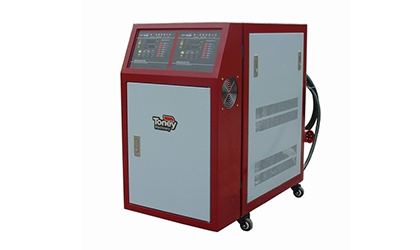 Current position:
Home
Current position:
Home
 news details
news details

Application of mold temperature machine in mold application of mold temperature machine in injection mold
1. The thermal balance of the injection mold controls the heat transfer of the injection molding machine and the mold is the key to the production of injection molded parts. Inside the mold, heat from plastics (such as thermoplastics) is transferred to the steel of the material and the mold by heat radiation, and is transferred to the heat transfer fluid by convection. In addition, heat is transferred to the atmosphere and the formwork by thermal radiation. The heat absorbed by the heat transfer fluid is carried away by the mold temperature machine. The heat balance of the mold can be described as: P = Pm - Ps. Where P is the heat taken away by the mold temperature machine; Pm is the heat introduced by the plastic; Ps is the heat that the mold emits to the atmosphere.

2. The purpose of controlling the mold temperature and the influence of the mold temperature on the injection molded part In the injection molding process, the main purpose of controlling the mold temperature is to heat the mold to the working temperature, and the second is to keep the mold temperature constant at the working temperature. If the above two points are successful, the cycle time can be optimized to ensure the high quality of the injection molded parts. Mold temperature affects surface quality, fluidity, shrinkage, injection cycle and deformation. Excessive or insufficient mold temperature can have different effects on different materials. For thermoplastics, higher mold temperatures generally improve surface quality and flow, but extend cooling time and injection cycle times. A lower mold temperature will reduce the shrinkage in the mold, but will increase the shrinkage of the molded part after demolding. For thermoset plastics, a higher mold temperature typically reduces cycle time, and the time is determined by the time required to cool the part. In addition, in the processing of plastics, a higher mold temperature will also reduce the plasticizing time and reduce the number of cycles.
3. Pre-conditions for effective control of mold temperature The temperature control system consists of three parts: mold, mold temperature machine and heat transfer fluid. In order to ensure that heat can be added to the mold or removed, the various parts of the system must meet the following conditions: First, inside the mold, the surface area of the cooling passage must be large enough, and the diameter of the flow path should match the pump capacity (pump pressure). The temperature distribution in the cavity has a large influence on the deformation and internal pressure of the part. Properly setting the cooling channel reduces the internal pressure and improves the quality of the molded part. It also reduces cycle times and reduces product costs. Secondly, the mold temperature machine must be able to keep the temperature of the heat transfer fluid constant within the range of 1 ° C - 3 ° C, depending on the quality requirements of the injection molded parts. The third is that the heat transfer fluid must have good thermal conductivity and, most importantly, it must be able to introduce or derive a large amount of heat in a short period of time. From a thermodynamic point of view, water is significantly better than oil.
4. Working principle The mold temperature machine consists of water tank, heating and cooling system, power transmission system, liquid level control system, temperature sensor and injection port. Typically, the pump in the power transmission system causes the hot fluid to reach the mold from the tank with the built-in heater and cooler, and then return from the mold to the tank; the temperature sensor measures the temperature of the hot fluid and transmits the data to the control section. Controller; the controller regulates the temperature of the hot fluid to indirectly adjust the temperature of the mold. If the mold temperature is in production and the temperature of the mold exceeds the set value of the controller, the controller opens the solenoid valve to open the inlet pipe until the temperature of the hot liquid, that is, the temperature of the mold returns to the set value. If the mold temperature is lower than the set value, the controller turns on the heater.
5. The type of mold temperature machine is divided according to the heat transfer fluid (water or heat transfer oil) used. The water-use mold temperature machine usually has a maximum outlet temperature of 95 °C. Use oil-operated mold temperature machine for working temperature ≥150 °C. Usually, the mold temperature machine with open water tank heating is suitable for water temperature or oil temperature machine, and the maximum outlet temperature is 90 ° C to 150 ° C. The main feature of this mold temperature machine is simple design and economical price. On the basis of this machine, a high-temperature water temperature machine is used, which allows an outlet temperature of 160 ° C or higher. Since the temperature is higher than 90 ° C, the thermal conductivity of water is higher than that of the same temperature. A lot better, so this machine has outstanding high temperature working ability. In addition to the second, there is a forced-flow mold temperature machine. For safety reasons, this mold temperature machine is designed to operate at temperatures above 150 ° C and uses heat transfer oil. In order to prevent overheating of the oil in the mold warmer heater, the machine uses a forced flow pumping system, and the heater consists of a number of tube stacks with finned heating elements for diversion.
6. Control the temperature in the mold to be uneven, which is also related to the time point in the injection cycle. The temperature of the cavity rises to the highest after injection, when the hot melt hits the cold wall of the cavity and the temperature drops to a minimum when the part is removed. The function of the mold temperature machine is to keep the temperature constant between θ2min and θ2max, that is, to prevent the temperature difference from fluctuating up and down in the production process or gap. The following control methods are suitable for controlling the temperature of the mold: Controlling fluid temperature is the most common method, and the control accuracy can meet most of the requirements. Using this control method, the temperature displayed in the controller and the mold temperature are not uniform; the temperature fluctuation of the mold is quite large, because the thermal factors affecting the mold are not directly measured and compensated for these factors including the injection cycle change, injection speed, melting temperature and Room temperature. The second is the direct control of the mold temperature. The method is to install a temperature sensor inside the mold, which is adopted when the mold temperature control accuracy requirement is relatively high. The main features of mold temperature control include: the temperature set by the controller is consistent with the mold temperature; the thermal factors affecting the mold can be directly measured and compensated. Typically, mold temperature stability is better than by controlling fluid temperature. In addition, mold temperature control is more reproducible in production process control. The third is joint control. Joint control is a combination of the above methods that simultaneously controls the temperature of the fluid and the mold. In joint control, the position of the temperature sensor in the mold is extremely important. When placing the temperature sensor, the shape, structure, and position of the cooling passage must be considered. In addition, the temperature sensor should be placed where the quality of the molded part is decisive. There are many ways to connect one or more mold temperature machines to the injection molding machine controller. It is best to use a digital interface such as RS 485 for consideration of operability, reliability and immunity. Information can be transferred between the control unit and the injection molding machine via software. The mold temperature machine can also be controlled automatically.
7. The configuration of the mold temperature machine and the configuration of the mold temperature machine should be comprehensively determined according to the processed materials, the weight of the mold, the required warm-up time and the productivity kg/h. When using heat transfer oil, the operator must comply with such safety regulations: Do not place the mold temperature machine close to the heat source furnace; the joint uses a taper leakproof and hose or tube with temperature and pressure resistance; periodic inspection Temperature control circuit mold temperature machine, joints and molds have leaks, function is normal; regular replacement of heat transfer oil; synthetic oil should be used, good thermal stability, small tendency to coking. In the use of the mold temperature machine, it is extremely important to select a suitable heat transfer fluid. Water is used as a heat transfer fluid. It is economical, clean and easy to use. Once the temperature control circuit leaks like a hose coupling, the water that flows out can be discharged directly to the sewer. However, water as a heat transfer fluid also has disadvantages: water has a low boiling point; depending on the composition of the water, corrosion and scaling may occur, causing an increase in pressure loss and a decrease in heat exchange efficiency between the mold and the fluid, and the like. When using water as a heat transfer fluid, the following precautions should be considered: pre-treatment of the temperature control circuit with an anti-corrosion agent; use of a filter before the water inlet; regular cleaning of the water temperature machine and mold with a descaling agent. There is no disadvantage of using water when using heat transfer oil. The boiling point of oil is high, they can be used for temperatures higher than 300 ° C or higher, but the heat transfer coefficient of heat transfer oil is only 1/3 of water, so the oil temperature machine has no extensive use of water temperature in injection molding.

Cloud
Copyright ? 2019 Guangdong Toney Robotic Intelligence Co.,Ltd.?All rights reserved. 粵ICP備12345678號
Technical support:XiaoHu

- online consultation
- QQ consultation
- back to top





